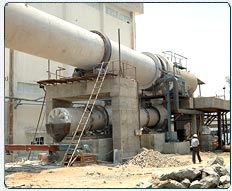Your Address : Globalchemmade--Nsi Equipments Private Limited
Name:Nsi Equipments Private Limited

Type:Others
Tel:+(91)-(121)-2519225/2529956
Fax:
Address:India
Equipments detail
| Equipment: | Rotary Kilns |  |
| Equipment Type: | Pressure Vessel -> Others | |
| Unit Type: | ||
| Technical Parameters: | ||
| Post Time: | 2010-12-21 | |
| Main Features: | ||
| Usage: | ||
| Description: | Standard Construction Features : Rotary Kilns are normally direct fired and lined with refractory material to protect the steel shell, reduce radiation losses and transfer heat to the material. A typical Rotary kiln is cylindrical shell, slightly inclined from the horizontal and supported on two or more tyres, which in turn rotate on rollers. One of the tyre is fixed axially by a set of thrust rollers to care of the thrust load during kiln movement. The drum assembly along with the tyres are rotated by a girth gear/ pinion arrangement. Shell diameter and length are generally designed to suit specific products. Heat Transfer in Rotary kiln : All kilns are heat exchangers and the heat is transferred in a variety of ways by radiation, convection and conduction. The most effective way of transferring heat is by gas radiation from the hot flame and a smaller amount of transfer from refractory. The hot bricks transfer by radiation to material and also by conduction to the charge Sealing arrangement : A seal is essential at each end to prevent ambient air from entering the process. Air leakage can have varying effects on different process. Sometimes it reduces efficiency and sometimes it can unsafe or unstable conditions. To maintain proper control of the volume and temperature of gases flowing through the kiln it is necessary to limit the leakage of the cold air in the kiln particularly where the rotating shell enters the feed and the discharge end hoods. Seal rings are provided for this purpose. Various types of seal rings are used which include spring loaded types, where two finished metal surfaces are in contact under spring pressure. The sealing segments require regular adjustment and ment. Refractory : Because of high temperature and abrasive material liner is required and call it as refractory. Refractory is installed as solid block to fit in to different areas tightly in round formation from sliding or falling out. There are many types of bricks in different composition and have different properties such as insulation value, maximum temperature and resistance to wear. Areas where brick can not be used liquid refractor called castables are used with anchor support. Kiln can also have insulation material under the brick and this extra layer helps to reduce shell losses. Bearings & Drive Components : The most common drive components are gear reducers. Gear reducers are used when reduced speed or increased torque is required. Gear reducers can be designed differently for applications. Rotary Kilns are normally gear driven through girth gear mounted over the shell on gear support base, assembled on a section of the shell away from the shell end where high temperatures are encountered. To compensate the thermal expansion the girth gear is mounted on tangential spring plates attached to the shell. The driving pinion is mounted on the output shaft of a worm / helical gear unit. Bearings are in every moving piece of equipment. Bearings are also uniquely designed for there application. The most common bearings are the anti-friction or roller bearings. These bearings have become standardized and perform excellent in almost any condition. Anti-friction bearings do not work well with heavy loads. Different kind of bearing are used on the kiln where high loads are seen. Firing System : The burner system is an important and an integral component of a rotary kiln system to optimize the combustion of fuels to release heat in the kiln. Safety considerations, ease and flexibility of operation, product quality, energy efficiency, maintenance costs, and the environmental impact of the products of combustion are some of the most critical areas that a kiln operator must evaluate in ing a kiln burner. In a rotary kiln application heat is injected directly in the end of the kiln. Firing systems could use any kind of fuel and be of any size. The burner is where the fuel is ignited. The fuel could be mixed with air before or in the burner. The flame temperature is a factor of fuel type, fuel/air ratio, and other burning conditions. Dust Collecting Equipments : Exhaust gases from an oil fired kiln contain certain proportion of very fine dust which becomes entrained in the air stream while in contact with materials being calcined. A Dust collector of high efficiency cyclone type is used. Even the most efficient cyclone type dust collector will not collect all the dust. Very fine particles which escape the dry collector may be recovered by mean of a wet collector in the form of sludge or alternatively by means of a Bag Filter Application : Rotary Kilns are used for the calcinations of Titanium dioxide, Illuminate, Kaolin, Barium Carbonate, Magnesium Carbonate, Silica Gel, Lime, Activated carbon, Vermiculite, Barium Sulfide, Magnesium oxide, petroleum coke, clay, gypsum, Alumina etc. | |